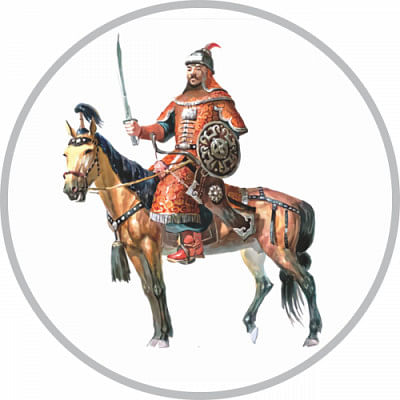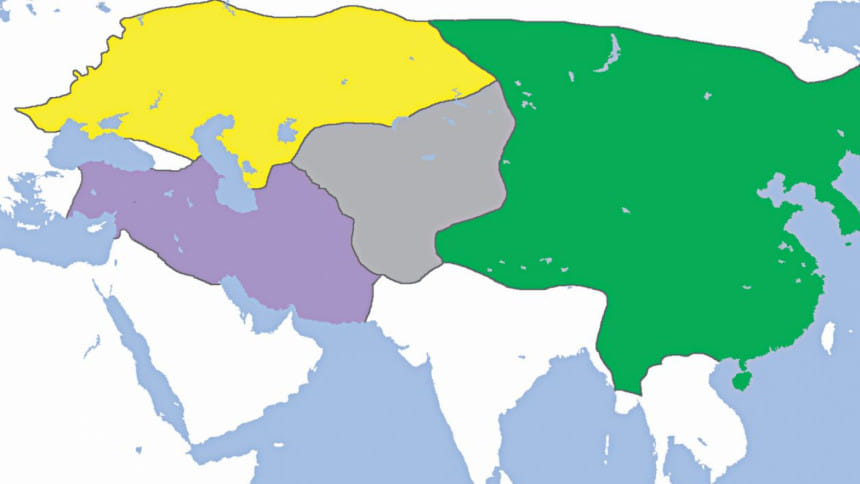The Big Mongol Break-up

History is basically the worst writer you can imagine. Always picks the least believable plots, over and over.
Take Genghis Khan of the Mongols, who came out of absolutely nowhere with a ferocious, motivated army of people no one had ever heard of before, and then used them to destroy and conquer the world's superpowers, carving out the world's largest contiguous land empire. That sort of thing shouldn't happen by any logic. It's like History makes this up as it goes along.
This meteoric rise to power couldn't have lasted, and it's a miracle the empire survived Genghis' death, all thanks to the Mongols' chain of command. Genghis' son and appointed heir Ogedei even expanded the Mongol empire into Europe. However, after he died the chieftains returned home to elect a new leader after which the title of Great Khan began to rest on decreasingly popular shoulders. The empire was stable enough to expand south into China and out into the Middle East, but after Mongke Khan died in 1259 the break-up was in full swing.
Empires don't disintegrate overnight, of course. The Mongol Empire shattered into four separate Khanates, each with its own unique history. Some of these Khanates produced lesser branches that lasted nearly into modernity, and some successors went onto become great civilisations of their own (*cough* Mughals *cough*).

Nominally, the one Khanate to rule them all was the Yuan Dynasty. This was Kublai Khan's branch of the Great Khan's family, who had specialised in bothering China, and in 1264 Kublai tried to move the Mongol capital to what is now Beijing. This abandonment of the homeland was the straw that broke the empire's back, and the various Khanates began to go their separate ways.
As the name suggests, the Yuan Dynasty were not merely China's foreign masters (the first ever), but a bona fide royal Chinese dynasty that held the Mandate of Heaven. (This is a tricky concept, but the short version is the Chinese accepted Kublai's rule as divinely-approved; you can't get more legitimate than that.) The Yuan Dynasty integrated itself into the culture of their new home, creating one of the most vibrant and powerful periods in Chinese history – but this ultimately led to their undoing as the greater Mongol people saw them as having gone too native. Increasingly weakened by isolation, Kublai's descendants lost the respect of the Chinese, leading to their defeat at the hands of the Ming Dynasty in 1368. The survivors retreated into Mongolia and resisted as the Norther Yuan Dynasty, and had many adventures and a spot of revenge too.
The northernmost of Khanates was the Golden Horde, founded by Batu Khan in 1243. After the empire started breaking up it went autonomous, and suffered the almost karmic fate of itself breaking up. At its height, the Golden Horde included the southern bits of modern Russia until western Siberia and extended west as far as the northern Black Sea. This vast region shattered into a collection of mini-Khanates as the succession grew controversial. The Rus, a divided people, began to band together and take these Khanates one by one, until finally the newly-formed Russian Empire (third largest empire in history) took the Crimean Khanate in 1783 – which was itself at the time a vassal of the Ottoman Empire. And that was that.
The Ilkhanate is interesting for having been the very southwestern branch of the former Mongol Empire – stretching from northwest Pakistan all the way to most of modern Turkey. Some of the later rulers even converted to Islam, beginning in 1259. Prior to that they were great enemies of the Muslims, which made them an attractive ally for the then still-a-thing crusaders. Luckily for the Muslim world, the crusaders never really managed to combine forces with the Ilkhanate – though there'd been an earlier attempt to woo Kublai Khan to the cause. The Ilkhanate eventually succumbed to the Black Death, and its last vestiges were cannibalised by the Golden Horde in 1357.
Now it's time to introduce the Mughals. Chagatai, son of Genghis Khan, founded his Khanate after his father's death and it went autonomous in 1266. By the 1340s the Chagatai Khanate had broken in half, with the nomadic Moghullistan to the east and a more orderly Khanate in Transoxiana to the west. Moghullistan produced the warrior Timur, descended from the Barlas who were part of the original army of Genghis Khan. Timur's story is Genghis Khan's in miniature – he conquered the remnants of the Chagatai Khanate to the west, effectively ending it, and conquered further westward – his empire shattering upon his death. His descendants included Babur. So begins the story of the Mughal Empire.
Now that we know, in summary, the fate of the Mongol empire and its branches, we can in the coming weeks tell a few interesting stories set during this period – a period that no self-respecting writer would ever have imagined, History, you hack.
Zoheb Mashiur is a prematurely balding man with bad facial hair and so does his best to avoid people. Ruin his efforts by writing to [email protected]

 For all latest news, follow The Daily Star's Google News channel.
For all latest news, follow The Daily Star's Google News channel. 



Comments